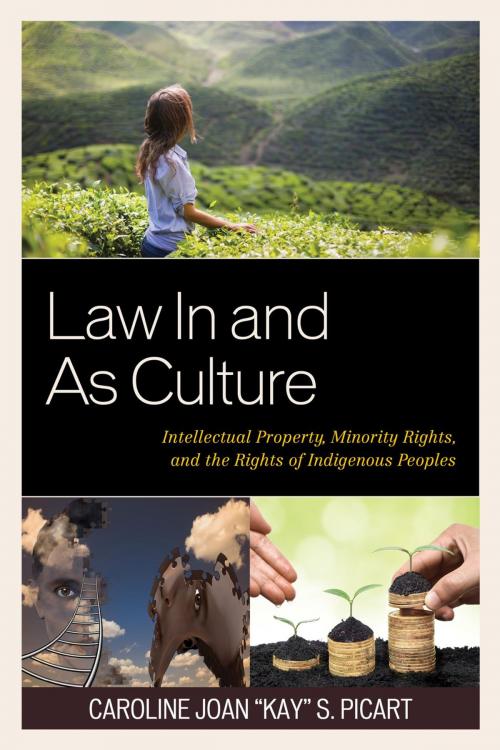Law In and As Culture
Intellectual Property, Minority Rights, and the Rights of Indigenous Peoples
Nonfiction, Reference & Language, Law, Federal Jurisdiction, Social & Cultural Studies, Social Science, Cultural Studies, Minority Studies, Popular Culture| Author: | Caroline Joan "Kay" S. Picart | ISBN: | 9781611477221 |
| Publisher: | Fairleigh Dickinson University Press | Publication: | March 4, 2016 |
| Imprint: | Fairleigh Dickinson University Press | Language: | English |
| Author: | Caroline Joan "Kay" S. Picart |
| ISBN: | 9781611477221 |
| Publisher: | Fairleigh Dickinson University Press |
| Publication: | March 4, 2016 |
| Imprint: | Fairleigh Dickinson University Press |
| Language: | English |
There are two oppositional narratives in relation to telling the story of indigenous peoples and minorities in relation to globalization and intellectual property rights. The first, the narrative of Optimism, is a story of the triumphant opening of brave new worlds of commercial integration and cultural inclusion. The second, the narrative of Fear, is a story of the endangerment, mourning, and loss of a traditional culture. While the story of Optimism deploys a rhetoric of commercial mobilization and “innovation,” the story of Fear emphasizes the rhetoric of preserving something “pure” and “traditional” that is “dying.” Both narratives have compelling rhetorical force, and actually need each other, in order to move their opposing audiences into action. However, as Picart shows, the realities behind these rhetorically framed political parables are more complex than a simple binary.
Hence, the book steers a careful path between hope rather than unbounded Optimism, and caution, rather than Fear, in exploring how law functions in and as culture as it contours the landscape of intellectual property rights, as experienced by indigenous peoples and minorities. Picart uses, among a variety of tools derived from law, critical and cultural studies, anthropology and communication, case studies to illustrate this approach. She tracks the fascinating stories of the controversies surrounding the ownership of a Taiwanese folk song; the struggle over control of the Mapuche’s traditional land in Chile against the backdrop of Chile’s drive towards modernization; the collaboration between the Kani tribe in India and a multinational corporation to patent an anti-fatigue chemical agent; the drive for respect and recognition by Australian Aboriginal artists for their visual expressions of folklore; and the challenges American women of color such as Josephine Baker and Katherine Dunham faced in relation to the evolving issues of choreography, improvisation and copyright. The book also analyzes the cultural conflicts that result from these encounters between indigenous populations or minorities and majority groups, reflects upon the ways in which these conflicts were negotiated or resolved, both nationally and internationally, and carefully explores proposals to mediate such conflicts.
There are two oppositional narratives in relation to telling the story of indigenous peoples and minorities in relation to globalization and intellectual property rights. The first, the narrative of Optimism, is a story of the triumphant opening of brave new worlds of commercial integration and cultural inclusion. The second, the narrative of Fear, is a story of the endangerment, mourning, and loss of a traditional culture. While the story of Optimism deploys a rhetoric of commercial mobilization and “innovation,” the story of Fear emphasizes the rhetoric of preserving something “pure” and “traditional” that is “dying.” Both narratives have compelling rhetorical force, and actually need each other, in order to move their opposing audiences into action. However, as Picart shows, the realities behind these rhetorically framed political parables are more complex than a simple binary.
Hence, the book steers a careful path between hope rather than unbounded Optimism, and caution, rather than Fear, in exploring how law functions in and as culture as it contours the landscape of intellectual property rights, as experienced by indigenous peoples and minorities. Picart uses, among a variety of tools derived from law, critical and cultural studies, anthropology and communication, case studies to illustrate this approach. She tracks the fascinating stories of the controversies surrounding the ownership of a Taiwanese folk song; the struggle over control of the Mapuche’s traditional land in Chile against the backdrop of Chile’s drive towards modernization; the collaboration between the Kani tribe in India and a multinational corporation to patent an anti-fatigue chemical agent; the drive for respect and recognition by Australian Aboriginal artists for their visual expressions of folklore; and the challenges American women of color such as Josephine Baker and Katherine Dunham faced in relation to the evolving issues of choreography, improvisation and copyright. The book also analyzes the cultural conflicts that result from these encounters between indigenous populations or minorities and majority groups, reflects upon the ways in which these conflicts were negotiated or resolved, both nationally and internationally, and carefully explores proposals to mediate such conflicts.















